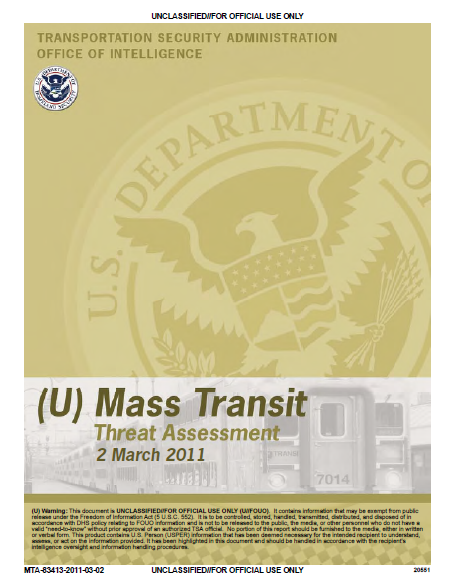Transportation Security Administration’s Office of Intelligence
- 10 pages
- For Official Use Only
- March 2, 2011
(U//FOUO) This Transportation Security Administration’s Office of Intelligence (TSAOI) annual Mass Transit Threat Assessment provides an overview of possible threats to the U.S. mass transit system, and presents conclusions regarding likely perpetrators, as well as their targets and weapons.
(U//FOUO) The U.S. mass transit system incorporates the passenger rail, heavy rail, light rail, and transit bus sectors. Approximately 6,000 mass transit agencies/authorities in the United States transport approximately 14 million people daily.
(U) Key Findings
(U//FOUO) TSA-OI assesses with high confidence that the current threat assessment level to U.S. mass transit systems is “medium”. TSA-OI’s assessment of the threat is based on recent disrupted plots in the Homeland, al-Qa’ida’s (AQ) stated intent, and worldwide terrorist attacks on mass transit systems. TSAOI has no current, credible threat information regarding imminent attacks on U.S. mass transit systems.
• (U//FOUO) Based on disrupted plots, TSA-OI assesses that AQ and its affiliates have demonstrated a continuing desire, intent, and capability to attack mass transit systems in the Homeland and remain the primary terrorist threat to the U.S. transportation industry.
• (U//FOUO) TSA-OI assesses that a terroristii attack against mass transit systems in the United States will most likely occur in a passenger rail car or station to generate fear and the greatest number of casualties.
• (U//FOUO) A review of terrorist attacks on overseas mass transit systems during the reporting period indicates that terrorists will most likely utilize improvised explosive devices (IEDs) or conduct armed assaults in a future terrorist attack against the U.S. mass transit system.
…
(U//FOUO) Terrorist groups aligned or in consultation with AQ have shown intent or demonstrated the capability to attack or engage in planning attacks against U.S. mass transit systems. TSA-OI assesses that AQ and its affiliates are the primary threat to mass transit systems in the Homeland.
(U//FOUO) For both rail and bus attacks, terrorists with secular, political, or anarchistic motives accounted for 47 percent of the 197 attacks on mass transit systems. Violent Islamic extremist groups—usually Sunni extremists—accounted for 20 percent of attacks. Shia and Jewish extremists accounted for 1 percent of all attacks. Perpetrators motivated by unknown causes were responsible for 32 percent of all attacks. (See Figures 2 and 3)
• (U//FOUO) May 2010: Faizal ShahzadUSPER was arrested in connection with a failed attack on Times Square in New York City. Shahzad admitted to law enforcement authorities that had his New York City’s Times Square attack been successful, he would have attacked other targets, including mass transit. Shahzad was trained for his attack by Tehrik-e Taliban Pakistan, a group allied with AQ.
• (U//FOUO) March 2010: In a video entitled “A Call to Arms,” AQ spokesperson Adam GadahnUSPER emphasized how even unsuccessful attacks on Western mass transportation systems could bring cities to a halt and cost billions in increased security measures.
• (U//FOUO) February 2010: Najibullah Zazi, a legal permanent resident of the United States from Afghanistan, admitted to bringing triacetone triperoxide (TATP) explosives to New York City in September 2009, as part of a plan to attack the New York City subway system. Zazi had previously traveled to Afghanistan and Pakistan to join the Taliban and fight against the United States and allied forces, and was recruited there by AQ to return to the United States and conduct a suicide bombing.(U//FOUO) No U.S. domestic terrorist groups have expressed the intent to carry out an attack on U.S. mass transit systems.
(U) Targets
(U//FOUO) During this reporting period, terrorists conducted attacks on a variety of rail and bus targets overseas, with the majority being against railroad tracks and bridges, and buses targeted from the outside. Sometimes a single operation included one or more targets (e.g., railcars were blown up inside a railway station or an IED damaged a bus stop and the bus).
…
(U//FOUO) TSA-OI currently has no credible intelligence suggesting that transnational or domestic extremists are actively plotting an attack against the mass transit system in the Homeland. AQ and its affiliates remain the primary threat to U.S. mass transit systems, and remain intent on planning attacks against transportation systems inside the Homeland. TSA-OI assesses that IEDs and assaults will be the most likely tactics and that a passenger rail car or station will be the most likely targets for any future terrorist attack against the U.S. mass transit system. TSA-OI assesses with high confidence that the terrorism threat to U.S. mass transit system is medium.

